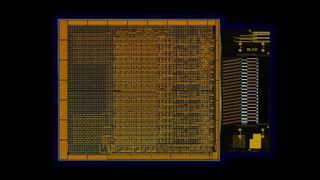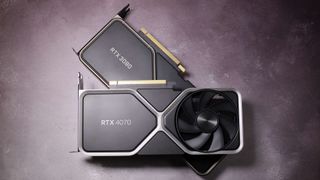Intel claims its optical interconnect chiplet technology is 'like going from using horse-drawn carriages to using cars and trucks'
It can deliver 4Tbps of bandwidth from 100m away.

At the Optical Fiber Communications Conference (OFC) 2024, Intel gave us a particularly interesting glimpse at what could be the future of chip and interconnect design. The Optical Compute Interconnect (OCI) chiplet integrates a Photonics Integrated Circuit (PIC) with an electrical IC. The chiplet was packaged with an Intel CPU and shown running live data.
Intel believes this technology is a game changer as it meets increasing demand for higher bandwidth across greater distances, while using less power. Of course, the initial applications will be used for AI infrastructure and HPC environments, where scalability concerns across racks and clusters are becoming increasingly apparent in large scale deployments.
Intel's press release included the following statement: "As an analogy, replacing electrical I/O with optical I/O in CPUs and GPUs to transfer data is like going from using horse-drawn carriages to distribute goods, limited in capacity and range, to using cars and trucks that can deliver much larger quantities of goods over much longer distances. This level of improved performance and energy cost is what optical I/O solutions like Intel’s OCI chiplet emerging bring to AI scaling." That tells us where Intel believes the future of interconnect technology lies.
Although the OCI is a prototype, it already supports up to 4 terabits per second (Tbps) bidirectional data transfer across distances as far as 100 meters. Importantly, the technology is compatible with PCIe 5.0, making it relatively easy to integrate into existing PCIe compatible infrastructure.

Best CPU for gaming: The top chips from Intel and AMD.
Best gaming motherboard: The right boards.
Best graphics card: Your perfect pixel-pusher awaits.
Best SSD for gaming: Get into the game ahead of the rest.
In terms of power savings, Intel claims its solution is much more efficient, consuming only 5 pico-joules (pJ) per bit compared to pluggable optical transceiver modules at about 15 pJ/bit.
The OCI chiplet can be integrated with future CPUs, GPUs and SoCs. Should the technology reach the consumer space in the years ahead—and if it takes off in the enterprise space there's little reason to doubt it will—then PCs in the years ahead could look very different.
Imagine being able to install a GPU that doesn't require a PCIe slot. You could install it anywhere in a compatible case, and connect it to a motherboard via a cable without any loss of performance. That should lead to improved cooling performance and potentially simpler (and cheaper) motherboard designs.
The biggest gaming news, reviews and hardware deals
Keep up to date with the most important stories and the best deals, as picked by the PC Gamer team.
Intel says it has developed a new silicon photonics fabrication process and it expects the technology to scale from the 4 Tbps range to tens of Tbps in the future. Chips with optical interconnects and glass substrates likely just got a step closer.
Exciting stuff!

Chris' gaming experiences go back to the mid-nineties when he conned his parents into buying an 'educational PC' that was conveniently overpowered to play Doom and Tie Fighter. He developed a love of extreme overclocking that destroyed his savings despite the cheaper hardware on offer via his job at a PC store. To afford more LN2 he began moonlighting as a reviewer for VR-Zone before jumping the fence to work for MSI Australia. Since then, he's gone back to journalism, enthusiastically reviewing the latest and greatest components for PC & Tech Authority, PC Powerplay and currently Australian Personal Computer magazine and PC Gamer. Chris still puts far too many hours into Borderlands 3, always striving to become a more efficient killer.
Most Popular







